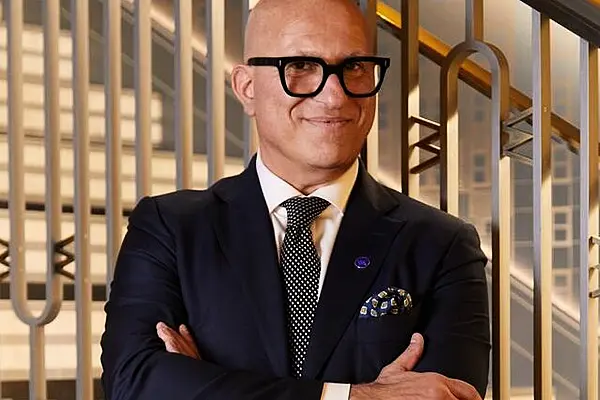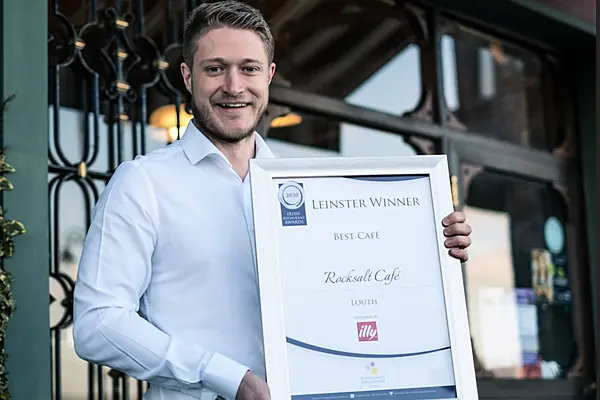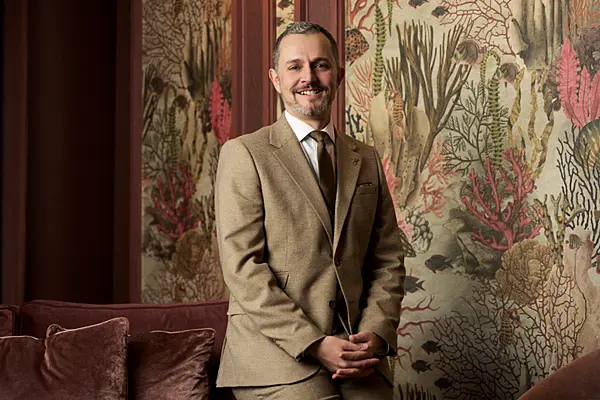Designer Bryan O’Sullivan has been responsible for projects including Claridge’s restaurant, in London, the Berkeley Bar & Terrace, the Red Room at the Connaught, and more. He talks to Hospitality Ireland about influences, family, and his new book, A New Glamour.
This article was originally published in the Autumn 2024 issue of Hospitality Ireland magazine, in October of 2024.
It’s something I always wanted to do, and it’s been a really nice way of capping off the first ten years of the studio.
Bryan O’Sullivan is talking about his book, A New Glamour, a full-colour record of some of the stunning design projects completed by his studio over the last ten years. There are restaurants in London and New York, hotels in London and Paris and on the French Riviera, and names such as the Berkeley, Claridge’s and the Connaught. Each one is unique and beautiful, showcasing Bryan’s distinctive intelligent, elegant contemporary style.
The book was initially suggested by Architectural Digest.
“We were doing work with them in America, and they suggested it and connected us with [publisher] Rizzoli. It happened totally organically – almost by accident.”
Bryan’s brother, Eamonn, is the book’s graphic designer.
“He is based in Kenmare, our hometown. He and his wife, Lizzie, work together. She is a textile designer, and she used to make all the cushions for our projects. Now they work together, in Anchor Studio, and my husband and I also work together – a family affair.”
Bryan and Eamonn’s father is Mickey Ned O’Sullivan, the legendary GAA player. He played ten seasons with the Kerry senior team, winning three All-Ireland medals, including as captain in 1975, and he was also manager, taking over from Mick O’Dwyer in 1989.
Kerry GAA, Bryan says, is “like a religion. It’s the biggest thing – it’s huge.” Did he play? “Not really. I played for a little bit in Kenmare, in primary school, and I was constantly” – here he mimics the kinds of things that he overheard – “‘That’s Mickey Ned’s son, and he’s crap at football!’” Did his dad mind? “No, never. He would have been very much, ‘Be your own person.'
He never put pressure on us to do anything. He was very encouraging of whatever we wanted to do.
“He’s the most Zen person,” Bryan continues. “My pals from school all call him Yoda. He just always has these great nuggets of advice that are always really positive. Nothing is a problem. I’ve never heard him say a bad word about anyone.
In fact, now he does a lot of work with us in the office in London and New York, team-building and one-on-one sessions with everyone. He’ll chat to them and see that they’re happy.
“We’ve all had terrible bosses in the past, toxic work environments, so what we wanted to do with our team was just make sure it’s not that environment – that everyone feels listened to, and it’s a nice place to come to work. He’s a big part of that. He was a teacher as well, so his whole life he’s worked with young people. He’s great at bringing the best out of people.”
When he was 12, Bryan was sent to boarding school in Dublin – Castleknock College, of which he says, “When you’re 12, it’s a bit of a culture shock, but I’d say six or seven of my best pals are guys from there. We’re still in touch daily. I see them all the time. You’re living with people 24/7. You develop really close bonds. It’s luck of the draw – you can have a good year or a bad year. We were lucky. We had a good year, and everyone got on. It was a really good experience.”
There, he played rugby, “up to about [age] 16. Then I lost interest, but I did really enjoy it when I did play. In that way, it was good that we went away to school. You were anonymous there, so it didn’t matter if you were good or bad.”
In terms of direct and obvious influence, it’s Bryan’s maternal grandfather who seems to have had the most impact.
“He started off in an orphanage,” Bryan says. “Both his parents died when he was very young. He went to London when he was 16 or 17 and worked on building sites, but he managed to get experience draughting and doing drawings. He was a builder by trade and a self-taught draftsperson. Then he moved back to Kerry and set up a building firm. From a humble start, he ended up having a good few hotels around the Ring of Kerry. He had a really good eye for design.”
In the book, Bryan writes about his earliest memories of design being at his grandfather’s house in Currow.
“He spent a lot of time drawing in his studio, which was filled with remnants of old statues and sections of stained glass that he had salvaged while restoring local churches. For a boy like me, it felt like Aladdin’s cave. I would sketch alongside him. He would teach me about floor plans and elevations. That was my initial crash course in architecture, though it would be years before I seriously considered it as a profession.”
Initially, Bryan wanted to study architecture after school, “but it was about 600 points at the time, so I didn’t even apply for it.” Instead, he opted for hospitality management.
“I used to chef a lot when I was younger, so I certainly had an interest in hospitality. My parents had restaurants and bars, and I had worked in them. I had also worked in Sheen Falls when they had a Michelin star, so you learned everything
in the kitchen, the proper way.”
He did a year of hospitality management in DIT Cathal Brugha Street, “but then I did a summer working in New York, on a building site down in Soho.
There was an architect on the project. They were doing up an apartment building, and I spent the whole summer in the office with the architect, going over all these details, and I realised, I definitely want to do this.”
He worked for a year as an intern with Duff Tisdall, then did the first part of his architecture degree at the University of Greenwich, and the second part at the University of Westminster, with a gap year in between in New York, where he worked with Annabelle Selldorf. During the summers, he worked part time in London, at David Collins Studio – “that’s how I got into interiors from architecture. When I finished studying, I worked for a year or so with him.”
David Collins, who died in 2013, was the remarkable designer – and friend of Madonna – behind projects including the Wolseley, Nobu, Harrods, and Restaurant Gordon Ramsay on Royal Hospital Road.
Of that time, Bryan says, “I was dazzled by everything, but especially by David. He was always around, sprinkling his magic dust on projects, from conception to completion. Like me, he was Irish and gay, so we had that in common. I was constantly amazed by his knowledge of design history and did my best to keep up, immersing myself in his vast library and absorbing his many references to interiors of the 1920s, ’30s and ’40s.”
Bryan started his own studio in 2013, with Evelyn Conway, and now employs 70+ people between two offices, in London and New York. “We spend about 60% of our time in London, and then we’re in New York.”
The studio’s first project – a private home in Ibiza – came to him through his now husband and business partner James O’Neill. James, who is commercial director, “came on boardabout six years ago, initially temporarily. He has an amazing business head, a he’s great with figures, so we’re on different sides of the business, which is good. Otherwise, I think we would kill each other, but he does also offer his opinion on the design side as well, and he has a really good eye. It definitely took a year or two of working together to understand our parameters and how not to push each other’s buttons. There’s definitely a ying-and-yang to be found!”
Right now, Bryan and James are working on “a hotel in South Beach Miami, partly landmarked as an art-deco building; a 1,900-square-foot house in the Hamptons for a fairly young client who has a great eye for design; a hotel in Mayfair, in a 1960s’ concrete building – quite brutalist; a hotel in the Seychelles; a few residential projects in London; andan ongoing project with Ballynahinch Castle as well. That’s where James and I got married, so that’s really special.”
Recently, the couple bought their own place in Kenmare, which “we’re going to start renovating. We’re in the design stage at the moment. It’s the one place I love going back to and fully recharging, going mountain-climbing, swimming in the sea. It’s my favourite place to go back to.








